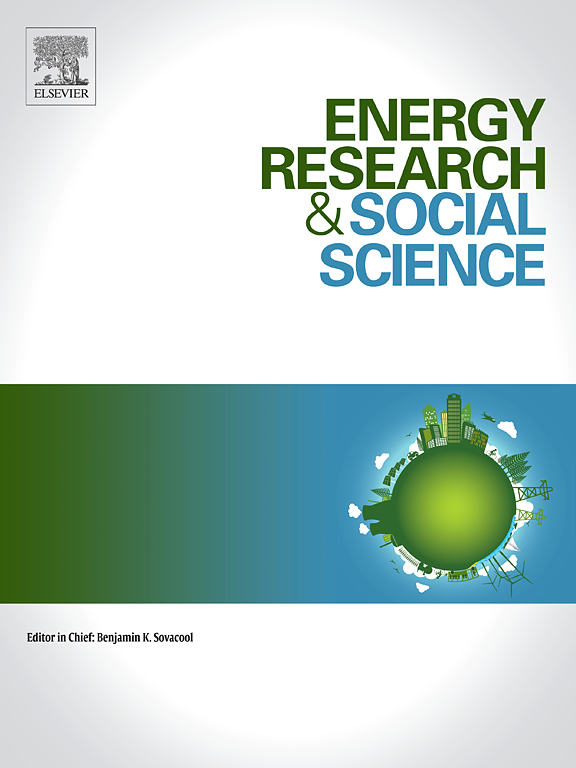Assessing the impact of off-grid solar electricity in protected areas: A capabilities analysis of the Kaimur Wildlife Sanctuary, India
IF 6.9
2区 经济学
Q1 ENVIRONMENTAL STUDIES
引用次数: 0
Abstract
This paper argues that simply increasing electricity connections may not result in the true realization of universal access to clean energy. It endorses the idea that energy services should be assessed from a capability perspective. Therefore, the study aims to assess the role of solar electricity in improving people's well-being on socioeconomic and environmental fronts. The data has been collected from 350 randomly selected households from 20 villages using a household schedule, and a qualitative approach has been used for analysis. Focused group discussions and key informant interviews have been used for in-depth understanding. The findings suggest that it has the potential to improve people's well-being by offering quality lighting, a healthy environment, and enhancing safety. Further, every household has been saving an average of 84 kg of CO2, 2 kg of black carbon, and 2 kg of PM2.5 emissions per year. Furthermore, they save ₹2200 on their lighting energy expenses and ₹600 on the social cost of CO2 emissions yearly. However, this does not create opportunities for new economic activities. Frequent failures of solar plants and a lack of maintenance services limit plants' lifespans and widen people's dissatisfaction. It can be a long-term solution for protected areas, but only if it adds value to their lives by offering livelihood opportunities and satisfying their aspirational demand. Reducing the electrician's workload can improve maintenance services. Improvements in plant lightning protection systems can help to avoid frequent breakdowns. Lastly, improving the complaint system and awareness regarding using appropriate electric appliances can be fruitful.
评估离网太阳能发电对保护区的影响:印度凯穆尔野生动物保护区的能力分析
本文认为,仅仅增加电力连接可能无法真正实现清洁能源的普及。本文赞同应从能力角度评估能源服务的观点。因此,本研究旨在评估太阳能发电在改善人们的社会经济和环境福祉方面的作用。研究使用家庭调查表从 20 个村庄随机抽取的 350 户家庭中收集数据,并采用定性方法进行分析。为深入了解情况,还进行了重点小组讨论和关键信息提供者访谈。研究结果表明,通过提供高质量的照明、健康的环境和更高的安全性,它有可能改善人们的福祉。此外,每个家庭平均每年可减少 84 千克二氧化碳、2 千克黑碳和 2 千克 PM2.5 排放。此外,他们每年还可节省 2200 英镑的照明能源支出和 600 英镑的二氧化碳排放社会成本。然而,这并没有为新的经济活动创造机会。太阳能发电站故障频发,缺乏维护服务,限制了发电站的使用寿命,扩大了人们的不满情绪。对于保护区来说,这可能是一个长期的解决方案,但前提是必须为他们的生活增值,提供谋生机会,满足他们的愿望需求。减少电工的工作量可以改善维护服务。改进工厂防雷系统有助于避免故障频发。最后,改进投诉制度,提高人们对使用适当电器的认识,也会取得成效。
本文章由计算机程序翻译,如有差异,请以英文原文为准。
求助全文
约1分钟内获得全文
求助全文
来源期刊

Energy Research & Social Science
ENVIRONMENTAL STUDIES-
CiteScore
14.00
自引率
16.40%
发文量
441
审稿时长
55 days
期刊介绍:
Energy Research & Social Science (ERSS) is a peer-reviewed international journal that publishes original research and review articles examining the relationship between energy systems and society. ERSS covers a range of topics revolving around the intersection of energy technologies, fuels, and resources on one side and social processes and influences - including communities of energy users, people affected by energy production, social institutions, customs, traditions, behaviors, and policies - on the other. Put another way, ERSS investigates the social system surrounding energy technology and hardware. ERSS is relevant for energy practitioners, researchers interested in the social aspects of energy production or use, and policymakers.
Energy Research & Social Science (ERSS) provides an interdisciplinary forum to discuss how social and technical issues related to energy production and consumption interact. Energy production, distribution, and consumption all have both technical and human components, and the latter involves the human causes and consequences of energy-related activities and processes as well as social structures that shape how people interact with energy systems. Energy analysis, therefore, needs to look beyond the dimensions of technology and economics to include these social and human elements.
 求助内容:
求助内容: 应助结果提醒方式:
应助结果提醒方式:


